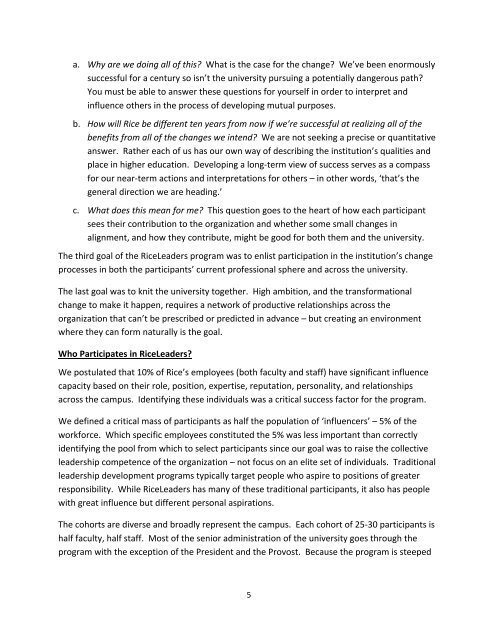Leadership Development in Support of Organizational Transformation
Leadership Development in Support of Organizational Transformation
Leadership Development in Support of Organizational Transformation
You also want an ePaper? Increase the reach of your titles
YUMPU automatically turns print PDFs into web optimized ePapers that Google loves.
a. Why are we do<strong>in</strong>g all <strong>of</strong> this? What is the case for the change? We’ve been enormously <br />
successful for a century so isn’t the university pursu<strong>in</strong>g a potentially dangerous path? <br />
You must be able to answer these questions for yourself <strong>in</strong> order to <strong>in</strong>terpret and <br />
<strong>in</strong>fluence others <strong>in</strong> the process <strong>of</strong> develop<strong>in</strong>g mutual purposes. <br />
b. How will Rice be different ten years from now if we’re successful at realiz<strong>in</strong>g all <strong>of</strong> the <br />
benefits from all <strong>of</strong> the changes we <strong>in</strong>tend? We are not seek<strong>in</strong>g a precise or quantitative <br />
answer. Rather each <strong>of</strong> us has our own way <strong>of</strong> describ<strong>in</strong>g the <strong>in</strong>stitution’s qualities and <br />
place <strong>in</strong> higher education. Develop<strong>in</strong>g a long-‐term view <strong>of</strong> success serves as a compass <br />
for our near-‐term actions and <strong>in</strong>terpretations for others – <strong>in</strong> other words, ‘that’s the <br />
general direction we are head<strong>in</strong>g.’ <br />
c. What does this mean for me? This question goes to the heart <strong>of</strong> how each participant <br />
sees their contribution to the organization and whether some small changes <strong>in</strong> <br />
alignment, and how they contribute, might be good for both them and the university. <br />
The third goal <strong>of</strong> the RiceLeaders program was to enlist participation <strong>in</strong> the <strong>in</strong>stitution’s change <br />
processes <strong>in</strong> both the participants’ current pr<strong>of</strong>essional sphere and across the university. <br />
The last goal was to knit the university together. High ambition, and the transformational <br />
change to make it happen, requires a network <strong>of</strong> productive relationships across the <br />
organization that can’t be prescribed or predicted <strong>in</strong> advance – but creat<strong>in</strong>g an environment <br />
where they can form naturally is the goal. <br />
Who Participates <strong>in</strong> RiceLeaders? <br />
We postulated that 10% <strong>of</strong> Rice’s employees (both faculty and staff) have significant <strong>in</strong>fluence <br />
capacity based on their role, position, expertise, reputation, personality, and relationships <br />
across the campus. Identify<strong>in</strong>g these <strong>in</strong>dividuals was a critical success factor for the program. <br />
We def<strong>in</strong>ed a critical mass <strong>of</strong> participants as half the population <strong>of</strong> ‘<strong>in</strong>fluencers’ – 5% <strong>of</strong> the <br />
workforce. Which specific employees constituted the 5% was less important than correctly <br />
identify<strong>in</strong>g the pool from which to select participants s<strong>in</strong>ce our goal was to raise the collective <br />
leadership competence <strong>of</strong> the organization – not focus on an elite set <strong>of</strong> <strong>in</strong>dividuals. Traditional <br />
leadership development programs typically target people who aspire to positions <strong>of</strong> greater <br />
responsibility. While RiceLeaders has many <strong>of</strong> these traditional participants, it also has people <br />
with great <strong>in</strong>fluence but different personal aspirations. <br />
The cohorts are diverse and broadly represent the campus. Each cohort <strong>of</strong> 25-‐30 participants is <br />
half faculty, half staff. Most <strong>of</strong> the senior adm<strong>in</strong>istration <strong>of</strong> the university goes through the <br />
program with the exception <strong>of</strong> the President and the Provost. Because the program is steeped <br />
5


